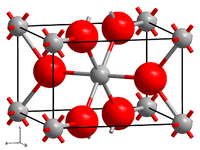Zinc fluoride
| Crystal structure | ||||||||||
|---|---|---|---|---|---|---|---|---|---|---|

|
||||||||||
| __ Zn 2+ __ F - | ||||||||||
| General | ||||||||||
| Surname | Zinc fluoride | |||||||||
| other names |
Zinc (II) fluoride |
|||||||||
| Ratio formula | ZnF 2 | |||||||||
| Brief description |
transparent, monoclinic crystals |
|||||||||
| External identifiers / databases | ||||||||||
|
||||||||||
| properties | ||||||||||
| Molar mass | 103.27 g mol −1 | |||||||||
| Physical state |
firmly |
|||||||||
| density |
4.95 g cm −3 |
|||||||||
| Melting point |
872 ° C |
|||||||||
| boiling point |
1500 ° C |
|||||||||
| solubility |
|
|||||||||
| Refractive index |
1.502 |
|||||||||
| safety instructions | ||||||||||
|
||||||||||
| As far as possible and customary, SI units are used. Unless otherwise noted, the data given apply to standard conditions . Refractive index: Na-D line , 20 ° C | ||||||||||
Zinc fluoride is a chemical compound of zinc and fluorine from the group of halides .
Extraction and presentation
Zinc fluoride can be obtained by the direct reaction of zinc with fluorine or by the reaction of hydrogen fluoride with zinc with the formation of hydrogen (H 2 ). It also occurs as a tetrahydrate . Alternatively, it can also be obtained from hydrogen fluoride and zinc carbonate .
properties
Zinc fluoride has a rutile crystal structure ( space group P 4 2 / mnm (space group no. 136) ) with six zinc atoms, which (in contrast to the other zinc halides) leads to an ionic bond and poor solubility in water. Zinc fluoride hydrolyzes in hot water to form zinc hydroxide fluoride Zn (OH) F.
use
Zinc fluoride serves as a wood preservative and can be used to produce other fluorine compounds such as phosphorus trifluoride .
literature
- R. Leckebusch, K. Recker: Color center studies on zinc fluoride single crystals. In: The natural sciences. 56, 1969, p. 511, doi : 10.1007 / BF00601966 .
- AG Banshchikov; NF Kartenko; AK Kaveev; MM Moisseeva; Nikolai S. Sokolov: Growth and structural characterization of ZnF2 epitaxial layers on Si . SPIE 5023, 10th International Symposium on Nanostructures: Physics and Technology, (June 11, 2003); doi : 10.1117 / 12.510497 .
Individual evidence
- ↑ Entry on zinc fluoride. In: Römpp Online . Georg Thieme Verlag, accessed on September 29, 2014.
- ↑ a b c d data sheet Zinc fluoride from Sigma-Aldrich , accessed on May 15, 2017 ( PDF ).
- ↑ a b Jean de Ans, Ellen Lax: Taschenbuch für Chemiker und Physiker: Volume 3: Elements, Inorganic ... Springer DE, 1998, ISBN 3-540-60035-3 , p. 810 ( limited preview in Google Book search).
- ↑ a b Georg Brauer (Ed.), With the collaboration of Marianne Baudler u a .: Handbook of Preparative Inorganic Chemistry. 3rd, revised edition. Volume I, Ferdinand Enke, Stuttgart 1975, ISBN 3-432-02328-6 .
- ↑ Zinc fluoride (tetrahydrate) data sheet from AlfaAesar, accessed on August 15, 2010 ( PDF )(JavaScript required) .
- ^ A b c Norman N. Greenwood, A. Earnshaw: Chemistry of the Elements. 2nd edition, Butterworth-Heinemann, Oxford 1997, ISBN 0-7506-3365-4 .
- ^ OK Srivastava, EA Secco: Studies on metal hydroxy compounds. I. Thermal analyzes of zinc derivatives ε-Zn (OH) 2 , Zn 5 (OH) 8 Cl 2 · H 2 O, β-ZnOHCl, and ZnOHF . In: Canadian Journal of Chemistry . 45 (6), 1967, pp. 579-583, doi : 10.1139 / v67-096 .
- ↑ Erwin Riedel: Inorganic Chemistry .


